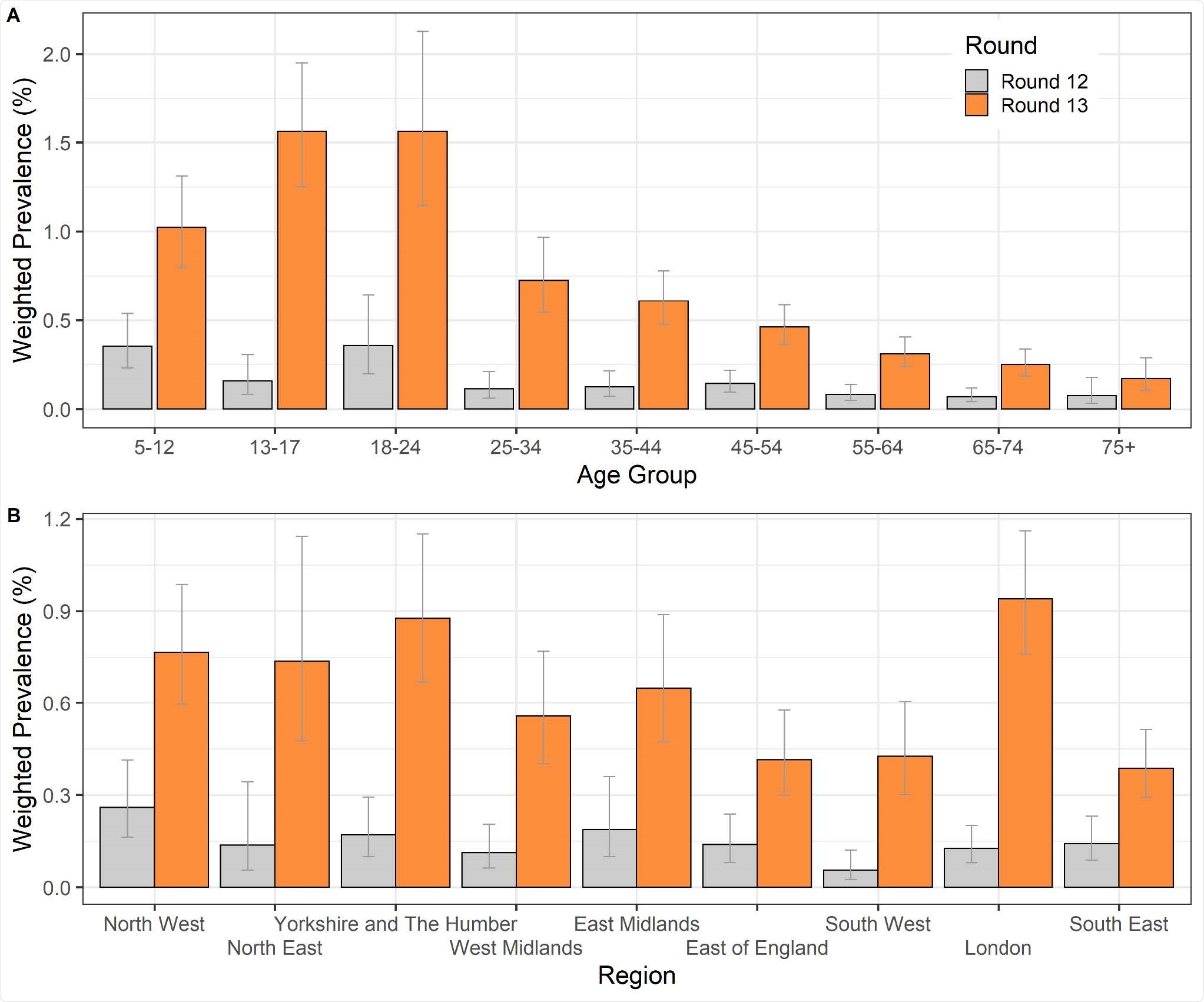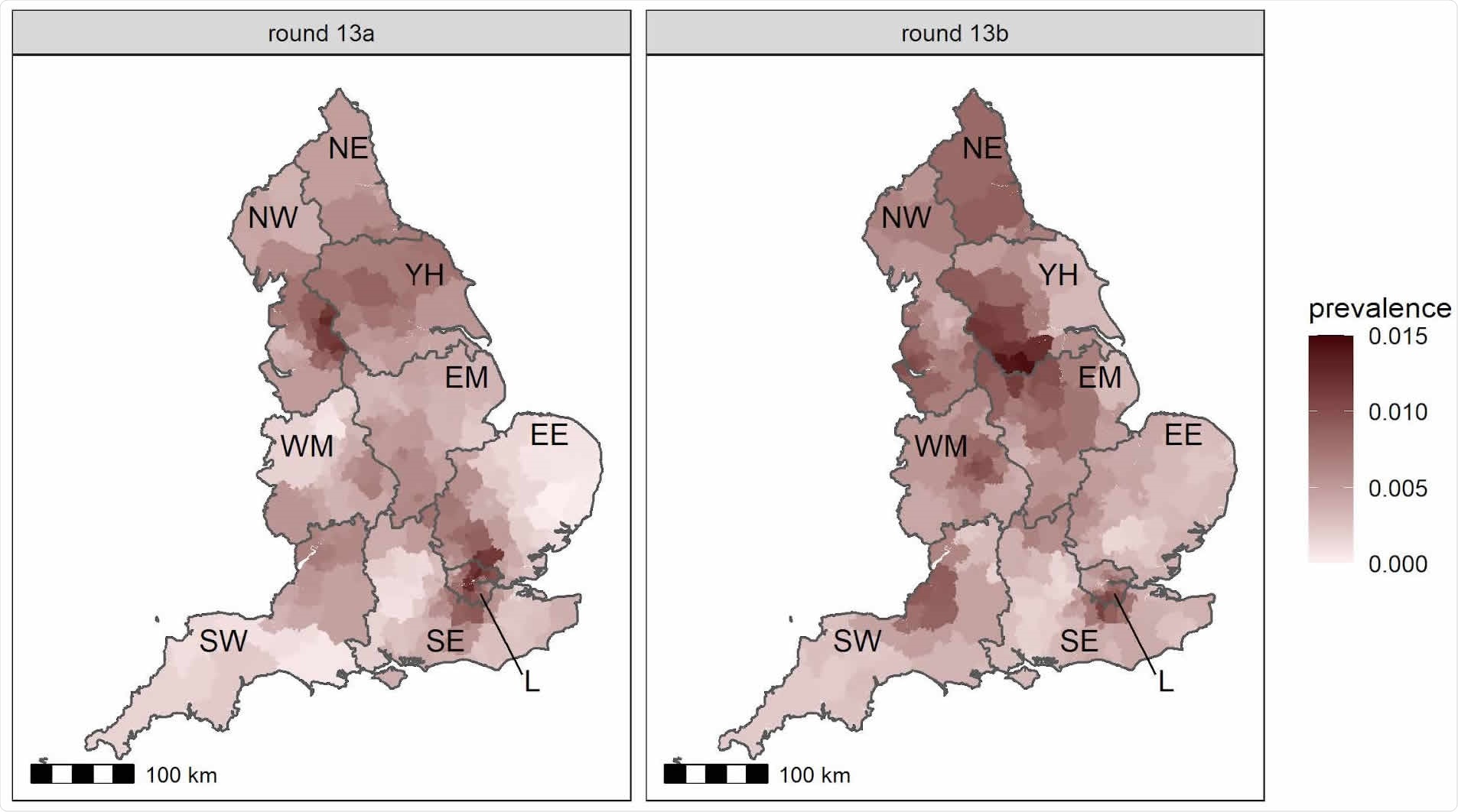Researchers in the UK have warned that England experienced a rapid exponential increase this summer in the prevalence of severe acute respiratory syndrome coronavirus 2 (SARS-CoV-2) – the agent that causes coronavirus disease 2019 (COVID-19) – despite high rates of vaccination uptake.
The researchers say that between the end of May and the beginning of July 2021, a substantial increase in SARS-CoV-2 cases was driven by the prevalence of the B.1.617.2 (delta) variant. Another driver of the trend was high infection rates among younger, unvaccinated individuals, despite the immunization program continuing to effectively reduce transmission.
Steven Riley from Imperial College London and colleagues recommend continuing the surveillance of SARS-CoV-2 prevalence and vaccination levels to monitor the spread of the COVID-19 epidemic.
A pre-print version of the research paper is available on the medRxiv* server, while the article undergoes peer review.
“Future SARS-CoV-2 trends are uncertain”
Despite the successful development and distribution of vaccines protecting against SARS-CoV-2 infection, the incidence of newly reported cases, hospitalizations and deaths has continued to rise in many northern hemisphere populations during the summer of 2021.
The proportion of cases caused by the B.1.617.2 lineage increased in many regions and some countries are evaluating the possibility that a further large wave of infections driven by this variant may occur in the autumn.
“As vaccination programs roll out globally and social distancing is relaxed, future SARS-CoV-2 trends are uncertain,” writes Riley and colleagues.
In England, there has been a substantial increase in the incidence of COVID-19 since the B.1.617.2 variant became established between April and May 2021.
During this same period, the UK government proceeded with the gradual relaxation of social distancing, with almost all legal restrictions being lifted in England on July 19th.
“While a much lower proportion of COVID-19 cases resulted in hospitalizations in England versus a comparable period of growth during autumn 2020, exponential growth in hospitalizations was still observed from mid-June 2021,” says Riley and the team.
What did the researchers do?
The researchers investigated SARS-CoV-2 prevalence trends by analyzing reverse transcription-polymerase chain reaction (RT-PCR) swab-positivity data collected during the two most recent rounds (12 and 13) of the REal-time Assessment of Community Transmission-1 (REACT-1) study.

Weighted prevalence of swab-positivity by age group and by region for round 12 and round 13 complete. Bars show 95% confidence intervals. (A) Weighted prevalence of swab-positivity by age group. (B) Weighted prevalence of swab-positivity by region.

 This news article was a review of a preliminary scientific report that had not undergone peer-review at the time of publication. Since its initial publication, the scientific report has now been peer reviewed and accepted for publication in a Scientific Journal. Links to the preliminary and peer-reviewed reports are available in the Sources section at the bottom of this article. View Sources
This news article was a review of a preliminary scientific report that had not undergone peer-review at the time of publication. Since its initial publication, the scientific report has now been peer reviewed and accepted for publication in a Scientific Journal. Links to the preliminary and peer-reviewed reports are available in the Sources section at the bottom of this article. View Sources
Results were obtained from 108,911 participants during round 12 (May 20th to June 7th, 2021) and from 98,233 participants during round 13 (June 24th to July 12th, 2021).
The average infection prevalence increased substantially in England between rounds 12 and 13, from 0.15% to 0.63%. This greater than four-fold rise occurred, despite England having one of the highest adult vaccination rates internationally.
Drivers of the increased prevalence
This rapid growth appears to have been driven by the complete replacement of the B.1.1.7 (alpha) lineage with the B.1.617.2 variant.
Of 254 lineages identified in round 13, 100% were the B.1.617.2 variant. This compares with 36 of 46 (78.3%) lineages identified during round 12, in which the remaining 10 were the B.1.1.7 variant.
The rapid growth in prevalence of infection also seemed to be driven by younger, less commonly vaccinated age groups, with a nine-fold increase observed between rounds 12 and 13 among those aged 13 to 17 years.
Individuals aged between 5 and 24 years were also over-represented among cases, contributing 50% of infections, while only representing 25% of the population in England aged 5 years or above.
“Therefore, during this period of rapid growth, any interventions targeted at the younger ages would have a disproportionate impact in slowing the epidemic,” writes Riley and colleagues.
More generally, individuals who reported being immunized were at a substantially reduced risk of testing positive for SARS-CoV-2, compared with those who reported being unvaccinated. In round 13, the prevalence of swab positivity across all age groups was three-fold greater among unvaccinated individuals than among those who were double-vaccinated, at 1.21% versus 0.40%.
However, in round 12, 29% of infections in England occurred in fully vaccinated people, with this figure rising to 44% in round 13, reflecting imperfect vaccine efficacy, despite high overall uptake levels.

Neighborhood smoothed average prevalence by lower-tier local area for (A) round 13a and (B) round 13b. Neighbourhood prevalence was calculated from nearest neighbors (the median number of neighbors within 30 km in the study). Average neighborhood prevalence displayed for individual lower-tier local authorities. Regions: NE = North East, NW = North West, YH = Yorkshire and The Humber, EM = East Midlands, WM = West Midlands, EE = East of England, L = London, SE = South East, SW = South West.
Scope for interventions to reduce transmission among younger, unvaccinated people
“From the end May to the beginning July 2021 in England, where there has been a highly successful vaccination campaign with high vaccine uptake, infections were increasing exponentially driven by the delta variant and high infection prevalence among younger, unvaccinated individuals despite double vaccination continuing to effectively reduce transmission,” write the researchers.
The team says this focus of infection offers considerable scope for interventions to reduce transmission among younger people, with knock-on benefits across the entire population.
“Level or declining prevalence may be observed during the summer in the northern hemisphere, reflecting school vacations, greater time spent outdoors, and reduced social interactions,” says Riley and colleagues.
However, without additional interventions, increased mixing during the autumn in the presence of B.1617.2 may lead to renewed growth, even at high levels of vaccination, they add.
“Continued surveillance to monitor the spread of the epidemic is therefore required,” concludes the team.

 This news article was a review of a preliminary scientific report that had not undergone peer-review at the time of publication. Since its initial publication, the scientific report has now been peer reviewed and accepted for publication in a Scientific Journal. Links to the preliminary and peer-reviewed reports are available in the Sources section at the bottom of this article. View Sources
This news article was a review of a preliminary scientific report that had not undergone peer-review at the time of publication. Since its initial publication, the scientific report has now been peer reviewed and accepted for publication in a Scientific Journal. Links to the preliminary and peer-reviewed reports are available in the Sources section at the bottom of this article. View Sources
Journal references:
- Preliminary scientific report.
REACT-1 round 13 final report: exponential growth, high prevalence of SARS-CoV-2 and vaccine effectiveness associated with Delta variant in England during May to July 2021. medRxiv, 2021. doi: https://doi.org/10.1101/2021.09.02.21262979, https://www.medrxiv.org/content/10.1101/2021.09.02.21262979v1
- Peer reviewed and published scientific report.
Elliott, Paul, David Haw, Haowei Wang, Oliver Eales, Caroline E. Walters, Kylie E. C. Ainslie, Christina Atchison, et al. 2021. “Exponential Growth, High Prevalence of SARS-CoV-2, and Vaccine Effectiveness Associated with the Delta Variant.” Science, November. https://doi.org/10.1126/science.abl9551. https://www.science.org/doi/10.1126/science.abl9551.